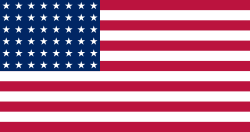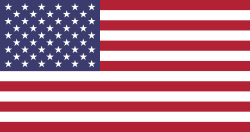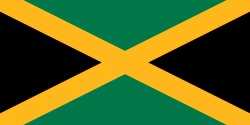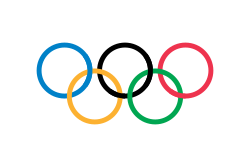Livio Berruti
| Livio Berruti Medaillenspiegel | ||
|---|---|---|
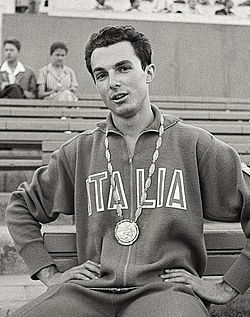 | ||
| Gold | Rom 1960 | 200 m |
| Gold | Neapel 1963 | 200 m |
| Gold | Neapel 1963 | 4 × 100 m |
| Silber | Neapel 1963 | 100 m |
| Silber | Tunis 1967 | 200 m |
| Universiade | ||
| Gold | Turin 1959 | 100 m |
| Gold | Turin 1959 | 200 m |
| Gold | Turin 1959 | 4 × 100 m |
| Bronze | Porto Alegre 1963 | 100 m |
| Bronze | Porto Alegre 1963 | 200 m |
| Gold | Tokio 1967 | 4 × 100 m |
Livio Berruti (* 19. Mai 1939 in Turin) ist ein ehemaliger italienischer Leichtathlet.
Leben
Trotz der Größe von 1,88 m betrug Berrutis Wettkampfgewicht nur 66 kg. Sein größter Erfolg war der Gewinn der olympischen Goldmedaille im 200-Meter-Lauf am 3. September 1960 in Rom.
Ergebnis:
- Livio Berruti (Italien) 20,5 s (elektronisch 20,62 s inoffiziell)
- Lester Nelson Carney (USA) 20,6 s (20,70 s)
- Abdoulaye Seye (Frankreich) 20,7 s (20,82 s)
- Marian Foik (Polen) 20,8 s (20,90 s)
- Stonewall Johnson (USA) 20,8 s (20,92 s)
- Otis Ray Norton (USA) 20,9 s (21,06 s)
Berruti lief am selben Tag bereits im Semifinale 20,5 s (20,65 s), was zur damaligen Zeit die Egalisierung des Weltrekordes für eine Rundbahn mit voller Kurve bedeutete. Am 100-Meter-Lauf nahm Berruti in Rom nicht teil. Seine Bestzeit über diese Strecke erzielte er am 26. Mai 1960 in Verona mit 10,2 s (handgestoppt).
Nach seinem Olympiasieg konnte er nicht mehr ganz an diese Leistungen anknüpfen, erreichte jedoch als bester Europäer im Finale der Olympischen Sommerspiele 1964 von Tokio in 20,8 s Platz 5. Es siegte Henry Carr (USA) in 20,3 s.
Weblinks
- Livio Berruti in der Datenbank von Olympedia.org (englisch)
| Personendaten | |
|---|---|
| NAME | Berruti, Livio |
| KURZBESCHREIBUNG | italienischer Leichtathlet |
| GEBURTSDATUM | 19. Mai 1939 |
| GEBURTSORT | Turin |
Auf dieser Seite verwendete Medien
Olympic Rings without "rims" (gaps between the rings), As used, eg. in the logos of the 2008 and 2016 Olympics. The colour scheme applied here was specified in 2023 guidelines.
Autor/Urheber:
unbekannt
, Lizenz: LogoLogo der Mittelmeerspiele. Die drei Ringe sympolisieren die drei Teilnehmer-Kontinente (Afrika, Asien, Europa). Die Wellen-Efekt soll das Mittelmeer symbolisieren.
Logo of FISU (wordmark)
US Flag with 45 stars. In use 4 July 1896–3 July 1908. Created by jacobolus using Adobe Illustrator, and released into the public domain. This flag was used during the Spanish-American War.
US Flag with 45 stars. In use 4 July 1896–3 July 1908. Created by jacobolus using Adobe Illustrator, and released into the public domain. This flag was used during the Spanish-American War.
US Flag with 48 stars. In use for 47 years from July 4, 1912, to July 3, 1959.
The Canadian Red Ensign used between 1921 and 1957.
This image has compared for accuracy (mainly colors) using an image from World Statesmen. The only change is making the maple leaves green from red. This image has compared for accuracy (mainly colors) using an image from World Statesmen. The most recent version of this image has changed the harp into one with a female figure; see [http://flagspot.net/flags/ca-1921.html FOTW
The Canadian Red Ensign used between 1921 and 1957.
This image has compared for accuracy (mainly colors) using an image from World Statesmen. The only change is making the maple leaves green from red. This image has compared for accuracy (mainly colors) using an image from World Statesmen. The most recent version of this image has changed the harp into one with a female figure; see [http://flagspot.net/flags/ca-1921.html FOTW
Flag of Italy from 1946 to 2003, when exact colors were specified.
(c) I, Cmapm, CC BY-SA 3.0
The flag of the Soviet Union (1955-1991) using a darker shade of red.
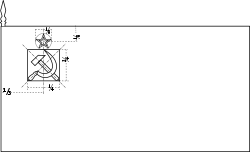
(c) I, Cmapm, CC BY-SA 3.0
The flag of the Soviet Union (1955-1991) using a darker shade of red.

Olympische Flagge
Flag of Canada introduced in 1965, using Pantone colours. This design replaced the Canadian Red Ensign design.
Livio Berruti at the 1960 Olympics






